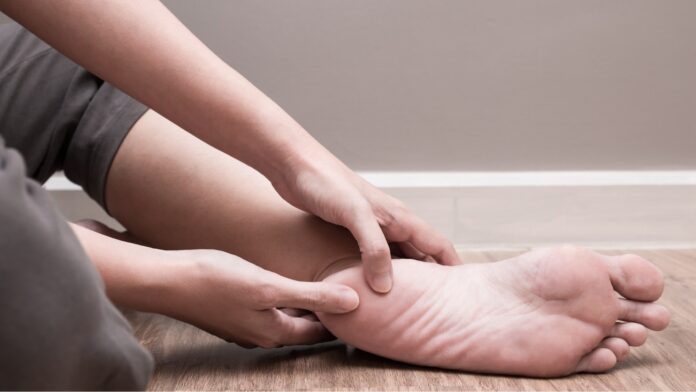Your heel is a vital structure that bears the weight of your body. A multitude of bones, joints, tendons and ligaments make up this weight-bearing part of the body. Therefore, the heel is prone to sprains, strains and inflammation. Do you suffer from continuing heel pain? Chances are it might be plantar fasciitis. Read on and we’ll discuss what this condition is, its causes and how to treat it.
Heel Pain
Increased weight of the body or overuse of the foot can lead to wear and tear of the heel’s ligaments and tendons. To know what types of injuries can lead to heel pain, let’s first look at the heel’s important and high-risk structures that can cause heel pain.
Structures Of The Heel And Causes Of Heel Pain
A multitude of structures, i.e. bones, ligaments, muscles, etc. are involved in the formation of heels and the supporting your body’s weight. Any issues with any of these structures might result in heel pain. Plantar fasciitis is one of the more common causes of heel pain. Let’s delve into this some more.
Sprains
Sports injuries and physical activities can lead to sprains and strains on your foot. The severity of the injury may vary from minor to severe.
Calcaneus Fracture
Calcaneus is the largest bone of the heel. A fracture of this bone can lead to severe pain. The joint formed between the heel bone and talus (foot bone) is essential for the foot’s normal functioning.
Plantar Fascia And Plantar Fasciitis
The plantar fascia is a strong ligament that lies on your foot’s base and connects your heel to the foot. It is an excellent shock absorber and supports the weight of your body. Inflammation of the plantar fascia is known as plantar fasciitis and also known as heel spur syndrome. It is the leading cause of heel pain.
Achilles Tendon And Achilles Tendonitis
Achilles tendon is known for its strength. This is a tendon that connects the calf muscle to the heel, thereby linking the leg to the foot. Overuse or injury to the tendon can cause painful inflammation of the structure, or achilles tendonitis.
Plantar Fasciitis
Your heel pain may be a likely outcome of plantar fasciitis. This is the most common orthopedic issue faced by people between 40-70 years of age.
Causes And Risk Factors Of Plantar Fasciitis
- The greatest risk factor for plantar fasciitis is obesity. Obese people are more likely to suffer from plantar fasciitis
- Pregnant women are at risk of developing heel spurs and plantar fasciitis
- People with structural issues of the foot may encounter plantar fasciitis
- Walking or running for long distances can cause this
- Wearing improper shoes can also incur pain at the inferior heel
Signs And Symptoms Of Plantar Fasciitis
Plantar fasciitis is characterized by pain felt at the inferior heel, i.e. the lower bottom of the heel (in the area that cracks due to dryness). You can also feel it in the mid-foot area. The pain sensation is usually sharp and is worse in the morning. Some people also complain of a burning sensation. The pain relieves when you stop moving, but the initial steps are the hardest to take because of the pain. Prolonged activity may result in a flareup of symptoms.
Treatment Of Plantar Fasciitis
The treatment of plantar fasciitis involves different strategies some of which include:
- Resting and pain killers – Mild pain can easily be treated by taking painkillers. Local steroid injections are also shown to be effective in the management of plantar fasciitis. Plasma rich protein injection is also a potent treatment modality
- Ice massage – Ice massages are an easy home remedy in managing the pain in your heel
- Shock wave therapy – Extracorporeal shockwave therapy (a treatment modality used for kidney stones and physical therapy) can also help ease the symptoms in chronic patients
- Braces and supports – Using orthotic arch supports (medical devices to wear inside your shoe) and night splints can prevent damage and allow immobilization
- Oil massage – Massaging with essential oils (lavender and eucalyptus oil) may reduce pain and inflammation
- Stretching the foot – Carrying out stretches for plantar fasciitis is proven to be very useful
- Surgical treatment – for chronic and severe issues, surgery could be an option
An analytical study of 27 surgically treated plantar fasciitis cases found that removing the fibrotic (excessive deposition of connective tissue) and granulomatous (diseased) parts from the affected fascia (thin layer of connective tissue covering bones, joints, and other organs) has had satisfactory results.
Treatment For Other Types Of Heel Pain
The same strategies mentioned above can be employed to relieve heel pain. Additional measures in preventing heel pain can include:
- Taking pressure off the heels (i.e. through weight loss)
- Following a healthy diet
- Stretching of the muscles daily
There are a variety of reasons that can link to heel pain. Consult with your doctor and if they say it could be plantar fasciitis, then it is advised to take steps to provide relief. Ice massage and stretches are good at alleviating pain. Enhanced treatments include steroid injections and surgery.
References
Lemont, Harvey, Krista M. Ammirati, and Nsima Usen. “Plantar fasciitis: a degenerative process (fasciosis) without inflammation.” Journal of the American Podiatric Medical Association 93.3 (2003): 234-237.








